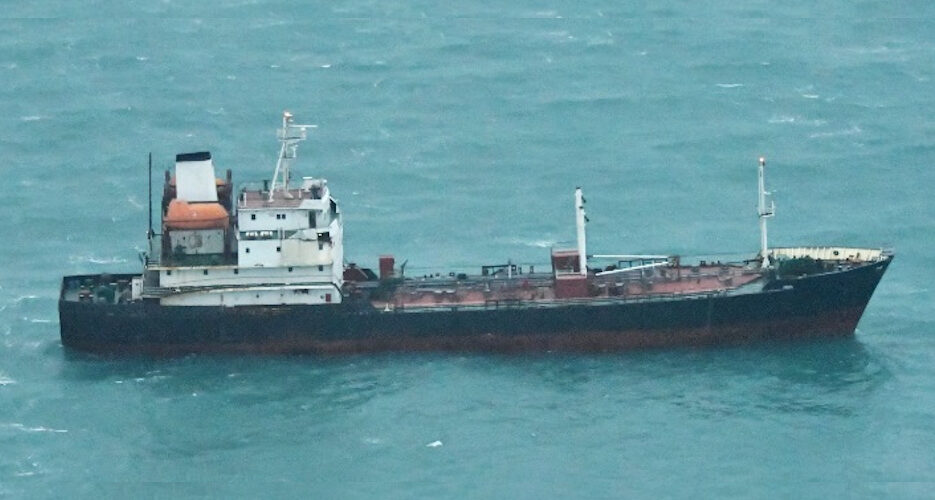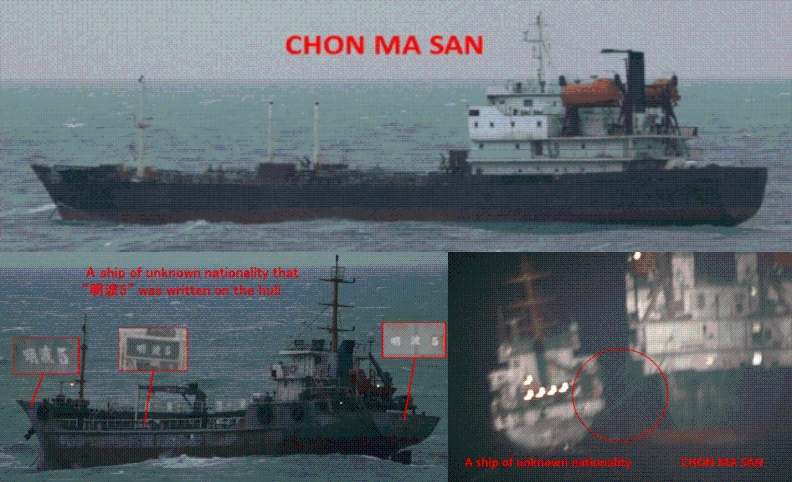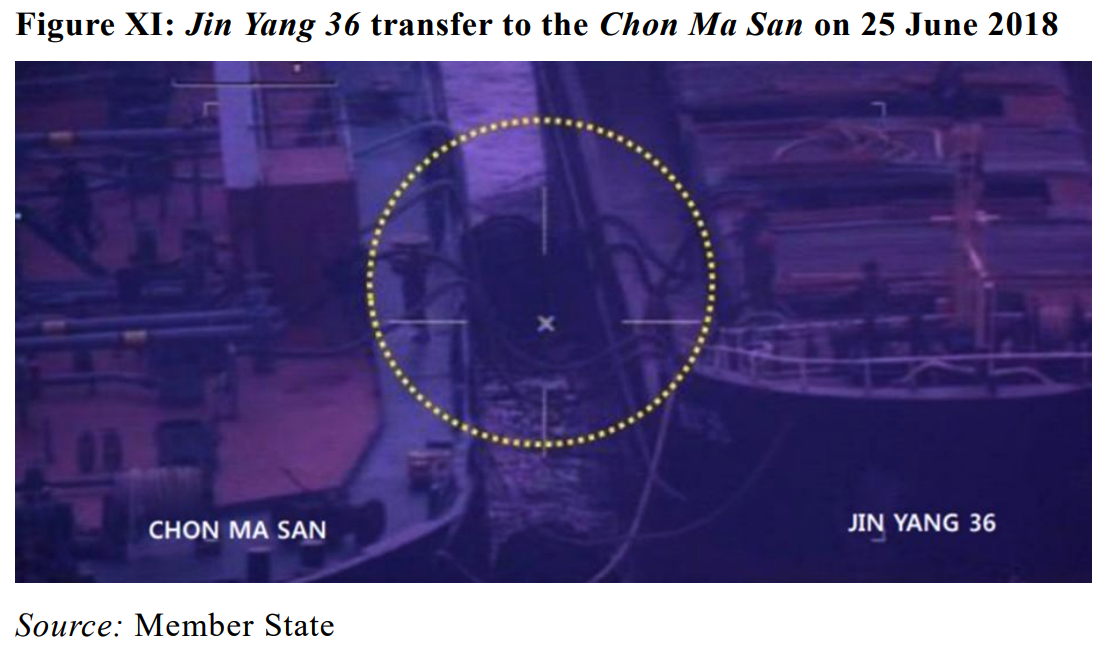
A sanctioned North Korean oil tanker
was photographed conducting a ship-to-ship (STS) transfer off the coast
of Shanghai in mid-January in violation of UN resolutions, according to
the latest in a series of reports on such activities from the Japanese Ministry of Foreign Affairs (MOFA).
Japan concluded that the Chon Ma San
(IMO number: 8660313), a vessel designated by the U.S. Treasury and the
UN in early 2018, was likely engaging in a STS transfer with another
vessel “of unknown nationality.”

The ship began broadcasting its
location again in October after an over-two-year hiatus, revealing at
least four trips through the strait between Korea and Japan and,
notably, a four-day period of circling in the strait following the
January STS transfer.
A photograph taken by the Japanese Tokiwa
replenishment tanker around midnight of January 11-12 showed the Chon
Ma San linked up with a ship with the name “明波5 (Ming Bo 5)” written in
Chinese characters on its hull.
The location of the suspected STS
transfer was “around 240km eastern offshore of Shanghai,” the MOFA
report, released on Friday, said.
STS transfers “of any goods or items
that are being supplied, sold, or transferred to or from the DPRK” were
banned under UN Security Council (UNSC) Resolution 2375 passed in
September 2017.

The Chon Ma San and its managing company, the Korea Achim Shipping Co., were added to the U.S. Treasury Office of Foreign Assets Control (OFAC) Specially Designated Nationals (SDN) list in February 2018.
On the very same day,
it was photographed by Japan Maritime Self-Defense Force aircraft
engaging in a STS transfer with the Maldivian-flagged tanker Xin Yuan 18
around the same location off Shanghai as in the latest case.
The UNSC North Korea sanctions committee followed in March that year by taking the recommendations of a member state and voting
to also sanction both the Chon Ma San and the Korea Achim Shipping Co.,
resulting in an asset freeze on the vessel and a ban on port calls to
member states.
The U.S. continued to pursue the North Korean tanker’s activities, and in August 2018
sanctioned two Russian entities connected to a Russian-flagged vessel
called the Patriot that was found to be engaging in STS transfers with
the Chon Ma San.

Treasury sanctioned the Primorye
Maritime Logistics Co Ltd and Gudzon Shipping Co LLC, the Patriot’s
“registered ship owners and managers,” after the vessel in early 2018
conducted a STS transfer of “2,000 tons of oil to the North
Korea-flagged M/V CHON MA SAN.”
“The ultimate buyer was UN- and
U.S.-designated Taesong Bank, a North Korean entity subordinate to the
UN- and U.S.-designated Workers’ Party of Korea Office 39, which engages
in illicit economic activities for North Korean leadership,” the
Treasury report added.
In another recorded instance of the Chon Ma San engaged in an STS transfer, the 2018 UN Panel of Experts (PoE) report
on North Korean sanctions detailed a case of the vessel around December
5 2017 linked up in the East China Sea with the Sierra Leone-flagged
tanker Jin Hye (IMO No. 8518572).
“The Chon Ma San disguised its
identity by painting the names ‘Whale’ and ‘Freetown (Sierra Leone)’
over the original name and port of registration and changing the “3”s to
“8”s in the IMO number on the superstructure (8660313 to 8660818),” the
report said, adding that “the flag of the [DPRK] on the funnel was also
painted over with white paint.”
The 2019 PoE report
said that, according to an unnamed member state, the Chon Ma San was
one of six of the “most active” vessels “accounting for 50 per cent of
all transfers” among 23 DPRK tankers being tracked for STS transfer
activity.
Additional cases in the report that
the Chon Ma San also “engaged in ship-to-ship transfers with and
received fuel from the Myong Ryu 1 and the Jin Yang 36 (金洋36), both of
unknown nationality, on 4 June and 25 June 2018.”
Friday’s report from the Japanese MOFA
was its 16th public report on North Korean STS transfers since the UN
resolution came into effect, covering the 24th such individual event
witnessed by Japanese and partner naval forces.
LOITERING AFTER THE TRANSFER
After disappearing from Automatic
Identification System (AIS) tracking services since June 2017, the Chon
Ma San reappeared on October 18 heading west through the Korea Strait
towards China, according to the Ship Tracker tool from NK News‘s sister site NK Pro.
This was the first of four instances
in the months since where the tanker broadcast its location when heading
through the strait, likely in order to avoid collisions in the narrow
waters as the AIS system is intended.
DPRK ships are otherwise known to turn off their broadcasting systems to avoid detection while conducting shipments considered illegal under UN sanctions.
Following the initial mid-October
broadcast, the Chon Ma San was then seen heading east through the strait
between November 30-December 1, presumably back towards one of North
Korea’s east coast ports, before being spotted heading back towards
China through the strait again from December 22-23.
It did not broadcast its location
again until after the January 12 reported STS transfer, but when it did
show up again in the Korea Strait at the end of the month, it exhibited
rather unusual activity.
NK Pro’s Ship Tracker shows the Chon
Ma San circling a large area in the strait between South Korea’s Jeju
Island and Japan’s Tsushima Island between January 27-30 before finally
heading east, presumably back to the DPRK east coast, on January 31.
The instance raises questions because the area is not a known hot spot for STS transfers, and due to the large area covered across the four days compared to past loitering of DPRK ships near the Chinese coast.
One potential explanation is that the
ship’s journey and possible scheduled return to the DPRK east coast was
interrupted by North Korea’s work to disinfect ports amid nationwide
efforts to prevent the spread of the novel coronavirus.
North Korea’s party-run daily the Rodong Sinmun reported on January 26
that the country was “tightening sanitary and quarantine inspection at
border areas, ports and airports to block the disease in advance.”
It is not clear if the end-of-January journey through the strait was
its first trip to North Korea after the January 12 STS transfer, though
it is a possibility given apparently consistent location broadcasting
since October in the high-traffic strait. The Chon Ma San may have also
traveled to the DPRK east coast port of Nampho in the interim.
Edited by Oliver Hotham
No comments:
Post a Comment